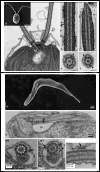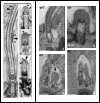Getting to the heart of intraflagellar transport using Trypanosoma and Chlamydomonas models: the strength is in their differences
- PMID: 24289478
- PMCID: PMC4015504
- DOI: 10.1186/2046-2530-2-16
Getting to the heart of intraflagellar transport using Trypanosoma and Chlamydomonas models: the strength is in their differences
Abstract
Cilia and flagella perform diverse roles in motility and sensory perception, and defects in their construction or their function are responsible for human genetic diseases termed ciliopathies. Cilia and flagella construction relies on intraflagellar transport (IFT), the bi-directional movement of 'trains' composed of protein complexes found between axoneme microtubules and the flagellum membrane. Although extensive information about IFT components and their mode of action were discovered in the green algae Chlamydomonas reinhardtii, other model organisms have revealed further insights about IFT. This is the case of Trypanosoma brucei, a flagellated protist responsible for sleeping sickness that is turning out to be an emerging model for studying IFT. In this article, we review different aspects of IFT, based on studies of Chlamydomonas and Trypanosoma. Data available from both models are examined to ask challenging questions about IFT such as the initiation of flagellum construction, the setting-up of IFT and the mode of formation of IFT trains, and their remodeling at the tip as well as their recycling at the base. Another outstanding question is the individual role played by the multiple IFT proteins. The use of different models, bringing their specific biological and experimental advantages, will be invaluable in order to obtain a global understanding of IFT.
Figures







Similar articles
-
Intraflagellar transport and functional analysis of genes required for flagellum formation in trypanosomes.Mol Biol Cell. 2008 Mar;19(3):929-44. doi: 10.1091/mbc.e07-08-0749. Epub 2007 Dec 19. Mol Biol Cell. 2008. PMID: 18094047 Free PMC article.
-
The distal central pair segment is structurally specialised and contributes to IFT turnaround and assembly of the tip capping structures in Chlamydomonas flagella.Biol Cell. 2022 Dec;114(12):349-364. doi: 10.1111/boc.202200038. Epub 2022 Sep 13. Biol Cell. 2022. PMID: 36101924
-
Intraflagellar transport proteins cycle between the flagellum and its base.J Cell Sci. 2013 Jan 1;126(Pt 1):327-38. doi: 10.1242/jcs.117069. Epub 2012 Sep 19. J Cell Sci. 2013. PMID: 22992454
-
The intraflagellar transport machinery of Chlamydomonas reinhardtii.Traffic. 2003 Jul;4(7):435-42. doi: 10.1034/j.1600-0854.2003.t01-1-00103.x. Traffic. 2003. PMID: 12795688 Review.
-
Intraflagellar transport.Annu Rev Cell Dev Biol. 2003;19:423-43. doi: 10.1146/annurev.cellbio.19.111401.091318. Annu Rev Cell Dev Biol. 2003. PMID: 14570576 Review.
Cited by
-
The intraflagellar transport dynein complex of trypanosomes is made of a heterodimer of dynein heavy chains and of light and intermediate chains of distinct functions.Mol Biol Cell. 2014 Sep 1;25(17):2620-33. doi: 10.1091/mbc.E14-05-0961. Epub 2014 Jul 2. Mol Biol Cell. 2014. PMID: 24989795 Free PMC article.
-
IFT46 Expression in the Nasal Mucosa of Primary Ciliary Dyskinesia Patients: Preliminary Study.Allergy Rhinol (Providence). 2021 Feb 11;12:2152656721989288. doi: 10.1177/2152656721989288. eCollection 2021 Jan-Dec. Allergy Rhinol (Providence). 2021. PMID: 33628615 Free PMC article.
-
Editorial.Cilia. 2014 Aug 18;3:8. doi: 10.1186/2046-2530-3-8. eCollection 2014. Cilia. 2014. PMID: 25136442 Free PMC article. No abstract available.
-
Mechanisms of spermiogenesis and spermiation and how they are disturbed.Spermatogenesis. 2015 Jan 26;4(2):e979623. doi: 10.4161/21565562.2014.979623. eCollection 2014 May-Aug. Spermatogenesis. 2015. PMID: 26413397 Free PMC article. Review.
-
Length regulation of multiple flagella that self-assemble from a shared pool of components.Elife. 2019 Oct 9;8:e42599. doi: 10.7554/eLife.42599. Elife. 2019. PMID: 31596235 Free PMC article.
References
-
- Li JB, Gerdes JM, Haycraft CJ, Fan Y, Teslovich TM, May-Simera H, Li H, Blacque OE, Li L, Leitch CC, Lewis RA, Green JS, Parfrey PS, Leroux MR, Davidson WS, Beales PL, Guay-Woodford LM, Yoder BK, Stormo GD, Katsanis N, Dutcher SK. Comparative genomics identifies a flagellar and basal body proteome that includes the BBS5 human disease gene. Cell. 2004;2:541–552. doi: 10.1016/S0092-8674(04)00450-7. - DOI - PubMed
-
- Kohl L, Bastin P. The flagellum of trypanosomes. Int Rev Cytol. 2005;2:227–285. - PubMed
-
- Besharse JC, Horst CJ. In: Ciliary and Flagellar Membranes. Bloodgood RA, editor. Plenum, New York, NY; 1990. The photoreceptor connecting cilium: a model for the transition zone; pp. 389–417.
LinkOut - more resources
Full Text Sources
Other Literature Sources

